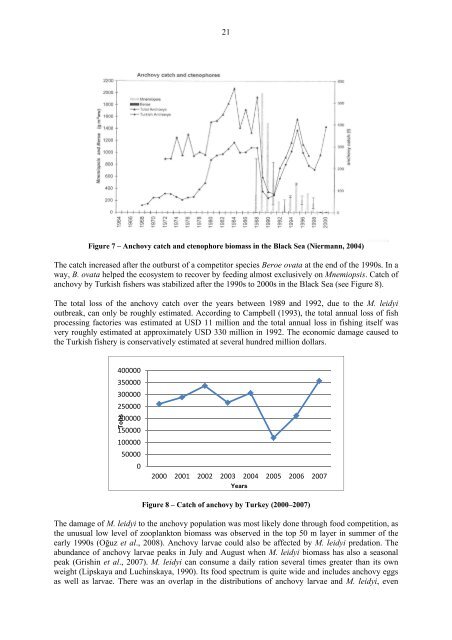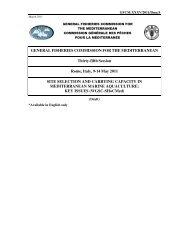Status of alien species in the Mediterranean and Black Sea
Status of alien species in the Mediterranean and Black Sea
Status of alien species in the Mediterranean and Black Sea
Create successful ePaper yourself
Turn your PDF publications into a flip-book with our unique Google optimized e-Paper software.
21<br />
Figure 7 – Anchovy catch <strong>and</strong> ctenophore biomass <strong>in</strong> <strong>the</strong> <strong>Black</strong> <strong>Sea</strong> (Niermann, 2004)<br />
The catch <strong>in</strong>creased after <strong>the</strong> outburst <strong>of</strong> a competitor <strong>species</strong> Beroe ovata at <strong>the</strong> end <strong>of</strong> <strong>the</strong> 1990s. In a<br />
way, B. ovata helped <strong>the</strong> ecosystem to recover by feed<strong>in</strong>g almost exclusively on Mnemiopsis. Catch <strong>of</strong><br />
anchovy by Turkish fishers was stabilized after <strong>the</strong> 1990s to 2000s <strong>in</strong> <strong>the</strong> <strong>Black</strong> <strong>Sea</strong> (see Figure 8).<br />
The total loss <strong>of</strong> <strong>the</strong> anchovy catch over <strong>the</strong> years between 1989 <strong>and</strong> 1992, due to <strong>the</strong> M. leidyi<br />
outbreak, can only be roughly estimated. Accord<strong>in</strong>g to Campbell (1993), <strong>the</strong> total annual loss <strong>of</strong> fish<br />
process<strong>in</strong>g factories was estimated at USD 11 million <strong>and</strong> <strong>the</strong> total annual loss <strong>in</strong> fish<strong>in</strong>g itself was<br />
very roughly estimated at approximately USD 330 million <strong>in</strong> 1992. The economic damage caused to<br />
<strong>the</strong> Turkish fishery is conservatively estimated at several hundred million dollars.<br />
400000<br />
350000<br />
300000<br />
250000<br />
200000<br />
Tons<br />
150000<br />
100000<br />
50000<br />
0<br />
2000 2001 2002 2003 2004 2005 2006 2007<br />
Years<br />
Figure 8 – Catch <strong>of</strong> anchovy by Turkey (2000–2007)<br />
The damage <strong>of</strong> M. leidyi to <strong>the</strong> anchovy population was most likely done through food competition, as<br />
<strong>the</strong> unusual low level <strong>of</strong> zooplankton biomass was observed <strong>in</strong> <strong>the</strong> top 50 m layer <strong>in</strong> summer <strong>of</strong> <strong>the</strong><br />
early 1990s (Oğuz et al., 2008). Anchovy larvae could also be affected by M. leidyi predation. The<br />
abundance <strong>of</strong> anchovy larvae peaks <strong>in</strong> July <strong>and</strong> August when M. leidyi biomass has also a seasonal<br />
peak (Grish<strong>in</strong> et al., 2007). M. leidyi can consume a daily ration several times greater than its own<br />
weight (Lipskaya <strong>and</strong> Luch<strong>in</strong>skaya, 1990). Its food spectrum is quite wide <strong>and</strong> <strong>in</strong>cludes anchovy eggs<br />
as well as larvae. There was an overlap <strong>in</strong> <strong>the</strong> distributions <strong>of</strong> anchovy larvae <strong>and</strong> M. leidyi, even
















